Star Trek: The Next Generation beamed onto our screens for the first time on September 28th, 1987. I hope that amidst the enjoyment of the recently-premiered Star Trek: Discovery, our first new Trek TV show in over a decade, there will be plenty of celebration of TNG’s 30th anniversary. I’ve written a bit about TNG before and I couldn’t resist joining in the fun of this special occasion.
While “Encounter at Farpoint” doesn’t necessarily stand the test of time as well as many subsequent TNG episodes (to be fair, pilots rarely do), it nevertheless launched the series in grand style and ushered in a new Golden Age of Trek. As a syndicated show, it “beat its prime-time network competition in Los Angeles, Dallas, Seattle, Miami, and Denver,” no small feat, and TV Guide called it a “worthy successor” to the original series. [*]
It also proved inspirational to the creators of future Trek series. Michael Piller, for example, one of the creative forces behind Star Trek: Deep Space Nine, recalled in an interview that delaying the introduction of several new DS9 characters until the pilot’s second and third acts was “one of the tricks I learned from watching ‘Farpoint.’” He goes on to say:
The other thing that comes out of “Farpoint” is a vision of Roddenberry’s where we have Picard arguing for the future of mankind representing the advocate of humanity to this Q who puts humanity on trial. That’s an extraordinary philosophically ambitious idea, and it really helps to define why Star Trek is what it is. Without that it would have been spaceships and monsters and special effects. [**]
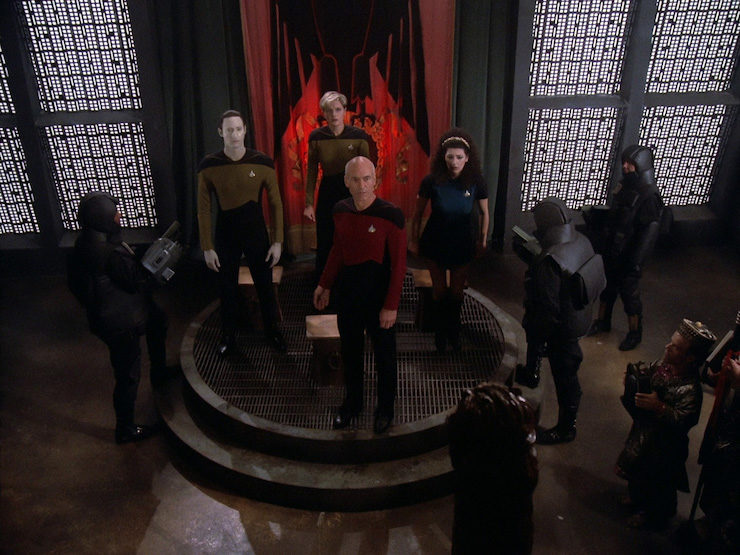
Certainly true, and one of the reasons that “Encounter at Farpoint”—which was perfectly end-capped and retroactively enhanced with the series’ Hugo-award winning finale, “All Good Things,” seven years later—is so memorable.
In the spirit of commemorating TNG’s seminal mission, I’d like to revisit the events involving Farpoint and try to examine them with a fresh set of eyes. After all, as Data says at the start of the episode, Starfleet’s orders are to “simply solve the mystery of Farpoint Station.” What if the mystery’s true solution has been overlooked—until now?
In the same playful way in which other authors, such as Pierre Bayard, have re-analyzed well-known fictional events and arrived at new “solutions” (in Bayard’s case, pertaining to Sherlock Holmes’ famous mystery The Hound of the Baskervilles), I’d like to suggest that perhaps what we commonly think happened during the Farpoint mission isn’t what really happened.
To discover the truth, all we need to do is follow the clues…
The Story In Brief
Jean-Luc Picard of the U.S.S. Enterprise, NCC-1701-D, a new Galaxy-class starship, must determine how a low-tech species known as the Bandi have been able to build the extremely impressive Farpoint Station. A being who identifies itself as a “Q” and appears to be all-powerful hijacks the Enterprise crew and sentences them to death on account of humanity being “a grievously savage race.” Picard intervenes and convinces Q to adjourn the trial long enough for humanity to prove what it has become, by solving the mystery of Farpoint Station. In time, Picard and his crew witness the arrival of a vast ship which fires on a Bandi city, and they realize that the ship is in fact a life-form attempting to free its mate from Bandi enslavement—the captive creature having been used to create Farpoint. Q states that he “will not promise never to appear again.”
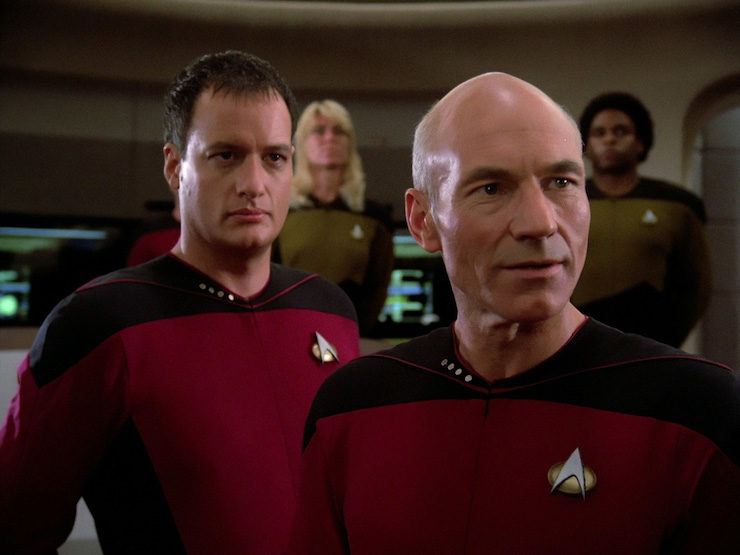
Episode Clues
- In his Captain’s Log, Jean-Luc Picard describes the ship as being en route to “the planet Deneb Four, beyond which lies the great unexplored mass of the galaxy.” This suggests that Farpoint station is at the edge of known space, at least as far as the Federation is concerned.
- Just before the Enterprise-D faces the first barrier field, Deanna Troi states, “Captain, I’m sensing a powerful mind.”
- After empathically sensing the creature self-identified as Q, Troi says: “Very, very advanced, sir, or certainly very, very different.”
- Zorn says: “Bandi do not enjoy leaving their home world.”
- Later, addressing Zorn, Data observes: “Our records show that you supervised all Bandi contact with other worlds.”
- When the two Farpoint creatures make contact, Troi says: “Sir! Wonderful! A feeling of great joy. And gratitude. Great joy and gratitude, from both of them.”
Novelization Clues
- When Data is speculating about Q, he suggests that “the being might not have been physically present at all. He might have been a projection or an illusion of some kind.” Data also says that “the being may have been a telepathic projection and therefore not detectable by sensors.”
- Later, Picard says to Q, “If we’re going to be tested, we prefer it to be on even terms.” The response: “‘I’m sure you would. How do you know it will be?’ Laughing, Q waved his hand toward them.”
- This description of the two Farpoint entities is interesting: “The bridge crew, Zorn and Q watched the screen as the two aliens closed, reaching toward each other with glowing, writhing extensions of delicate matter/ energy.” Previously we’ve been told that “Farpoint Station was shimmering, coalescing, growing soft around the edges. Slowly, it flowed into the shape of a gossamer creature, feathery light as it gracefully rose from its captivity.” Note the clear suggestions that the life-forms possess an intrinsic matter/energy exchange capacity, and that at least one of them can alter its shape.
- Q’s response upon Troi’s comment regarding the creature’s joy is also noteworthy: “Q sniffed disdainfully as the gracefully moving aliens pushed further away from the planet, heading for the depths of space. ‘So dull, once you know the answers.’” In other words, he immediately confirms that the mystery of Farpoint has been correctly solved.
Hypotheses
Taking stock of all the above clues, we can formulate two hypotheses:
Hypothesis 1: The various phenomena experienced by the Enterprise-D and her crew, all involving the sophisticated manipulations of energy and matter, are being caused by two distinct agents. Being Q is an omniscient, omnipotent alien life-form with a quirky sense of humor and an inclination to simultaneously judge and assist humanity, while the other type of entity, Being F (for Farpoint), is a space-faring life-form with the ability to read humanoid minds, render the thoughts of such minds into reality, and whose limitations and purpose are otherwise unknown.
This is the conventional interpretation of the Farpoint narrative.
But there’s another possibility:
Hypothesis 2: A single alien life-form is behind all the unusual phenomena shown throughout the two-part episode.

Implications
On the face of it, what seems more likely, that on its inaugural mission the Enterprise-D encountered two separate entities with the ability to convert matter into energy and vice-versa, or merely one?
Let us assume that the answer is one. In this case, which of the two Beings should we pick, the all-powerful Q or the very-powerful F? This seems straightforward. Per Occam’s Razor, in order that “entities should not be multiplied unnecessarily” (no pun intended) we should pick the being that requires the lowest level of metaphysical improbability. In our case, this is the F-type entity.
As we’ll see, all of the crew’s experiences may be explained simply by positing this second type of entity, the Farpoint life-form. In a way, Data himself suggests it in the novelization. Imagine he was right when he speculated that Q could be a telepathic projection. Based on our hypothesis, F is the entity responsible for the projection. To what end?
We can speculate that F seeks knowledge of humanity because humanity has made quick technological progress and is venturing through space in ever-greater numbers, perhaps encroaching on F’s domain or resources. F may also have wanted to create a dynamic in which it could influence humanity in the future, which would require relationship-building of some kind, and this could be best achieved by the telepathic broadcast of a form that appeared human. Why pick Q as a means of manifestation?

Again, we can fill in the blanks with the clues above. As F scanned humans’ minds (and possibly the ship’s computers), it learned of their history and it may have surmised that a god-like being (with suitable displays of powers to back up its grandiose claims) could be the best way to exert its influence. In other words, F, though extremely powerful, may have been self-aggrandizing as a means of intimidation. Some of F’s abilities, such as a sudden change of scenery, light and sound effects, and the materializing of beings from myth or history, are not unlike those of Ardra in the fourth-season episode “Devil’s Due.” If Q is a trick put on by F, then aspects of the trick can certainly be accounted for by sophisticated technology that transcends that of 24th-century humanity. In this sense, TNG itself provides a later blueprint for the idea.
You might be wondering, where do the Bandi fit in all this? F knows that humans thrive on discovery, on exploring the unknown, on solving mysteries. (In the fourth-season episode “Clues” Picard goes so far as to say, “to many humans, a mystery is irresistible. It must be solved.”) Given this human trait, if F wanted to lure humanity into a particular scenario, it might reasonably generate a fairly obvious and compelling mystery, that of a “miraculous” space station that would be sure to spark human interest. In order to keep itself secluded from the proceedings, at least initially, F would logically choose to act through an intermediary race. An ideal race would be one that doesn’t travel—and thus has limited experience dealing with challenging cosmic phenomena and life-forms, making them less suspicious of F’s true nature and abilities—and one in which contact with aliens is centralized to a small group or even a single individual, requiring fewer humanoids to manipulate. The Bandi fit these criteria perfectly, and they are ideally located. In order to get the Bandi to play their intended roles, F would then simply use its known mind-reading and object-materialization abilities, deceiving the Bandi into thinking they had successfully ensnared one of the F-type beings.
In this scenario, F only feigned weakness when humans investigated it, as a means of generating empathy and holding any suspicions about its true designs at bay.
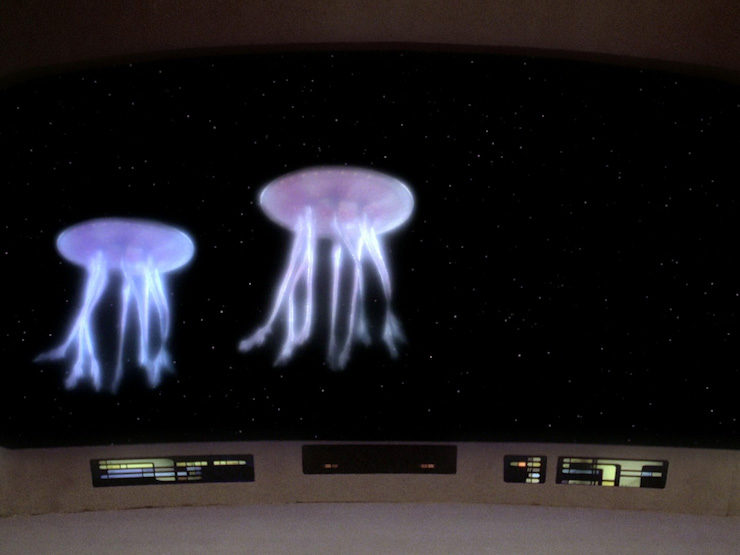
We can go farther. A good hypothesis should not only fit the available data, but also help to elucidate new insights about what’s been observed, such as the following items:
- Troi’s comment that she’s “sensing a powerful mind” is more reasonable in the context of the Enterprise-D interacting with F, an extremely advanced being, yet of ultimately finite power, than if she were sensing the mind of an omnipotent, omniscient entity (Q).
- On reflection, it seems unlikely that a truly omnipotent being (Q) would subject the human race, bound by ordinary space-time, to a test the outcome of which Q would have known instantaneously. Q would know ahead of time how the “trial” would turn out. Why go through the motions, given the outcome we’re shown?
- When Picard asks that humans be tested on even terms, the F-being can’t resist seeing the irony of the request, which is reflected in the Q-projection’s laughing at Picard.
- Considering the Enterprise-D’s mission statement to “seek out new life and new civilizations,” the crew makes remarkably little effort to communicate with or investigate the F-type creatures once they are seen together in space, despite their highly probable sentience. If the F beings had been pulling the strings all along, and wanted to keep the details of their nature secret (remember, the Enterprise-D is at the edge of known space, per the Captain’s log), this unusual behavior from Picard and company is exactly what we might expect to see. It also makes sense that they would flood Troi with feelings of well-being, as part of their distraction, and use their Q-projection to assure the crew that the mystery had been solved.
Naturally, the most far-reaching consequence of our reinterpretation is that, in this version of events, Q does not exist. Q is merely a sophisticated illusion generated by the Farpoint creatures, which they occasionally use to exert influence over us, to steer us in accordance with their wishes. What is their end game? To puzzle out the F-creature’s true agenda, we’d have to re-investigate each of “Q”’s appearances in the Star Trek universe and pay attention to all the subtle clues.
In Data’s immortal words, the game is afoot!
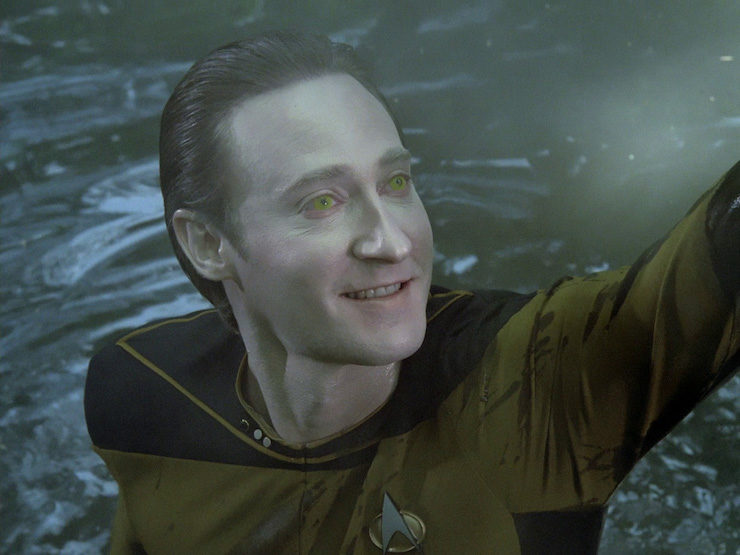
[*] Larry Nemecek. The Star Trek: The Next Generation Companion: Revised Edition.
[**] Edward Gross and Mark A. Altman. The Fifty-Year Mission: The Next 25 Years: From The Next Generation to J. J. Abrams: The Complete, Uncensored, and Unauthorized Oral History of Star Trek.
 Alvaro Zinos-Amaro is the author of the Hugo- and Locus-finalist Traveler of Worlds: Conversations With Robert Silverberg (2016). Alvaro has published many stories, essays, reviews, and interviews, as well as Rhysling-nominated poetry.
Alvaro Zinos-Amaro is the author of the Hugo- and Locus-finalist Traveler of Worlds: Conversations With Robert Silverberg (2016). Alvaro has published many stories, essays, reviews, and interviews, as well as Rhysling-nominated poetry.










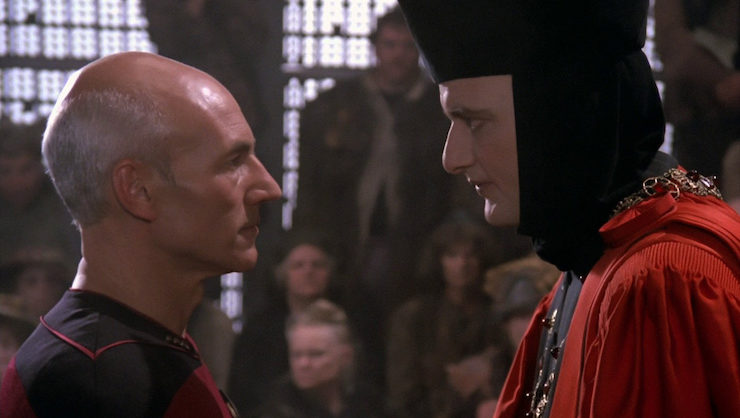
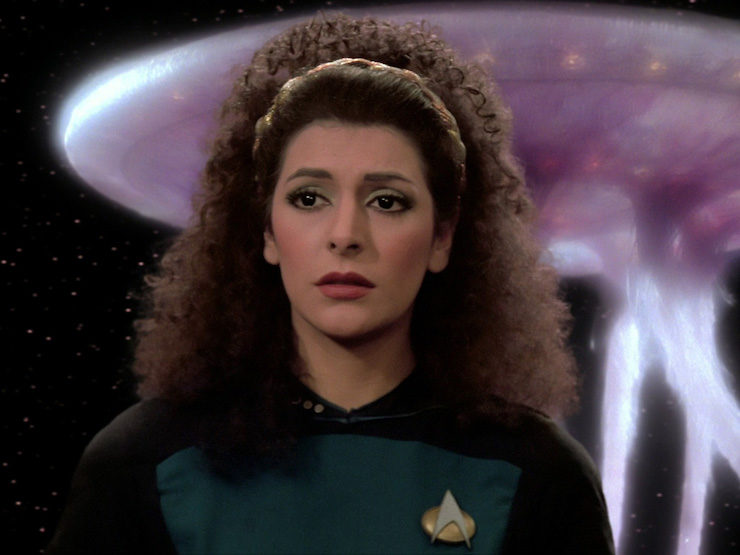
As you say, your interpretation of event means every further appearance of the Q is actually F, so F is at least exactly as powerful as the Q are considered to be: this completely negates your argument regarding Occam’s razor.
More likely, the Q have rules similar to the Prime directive regarding very advanced species, as those are the species that have a chance to reach their level; whereas they are quite lax about interactions with primitive species like humans. So Q wants to save this alien but can’t intervene directly. He might also be interested in this particular group of humans and this could be a good occasion to learn more about them. So he manipulates events in such a way that the F is saved without any direct intervention from his part.
…or it could be that Farpoint really sucked. That’s what explanation I’m going with.
How about the opposite of Athreeren’s idea – that F is another Q, and the whole thing was a setup/test of humanity? Recall the Voyager episode, “Q2,” where Q reveals himself to be the alien his son was interacting with, that it was all a test. Why couldn’t F have also been a Q (we know they can take any form), either one, or two….therefore, the Farpoint episode could’ve actually involved 3 Q – the one who allowed itself to be ‘held captive,’ the ‘angry mate’ trying to free it, and the Q who appeared on the Enterprise’s Bridge, to present the task & oversee the trial.
I like your reinterpretation/revisit of Encounter at Farpoint, Alvaro Zinos-Amaro, well done. :)